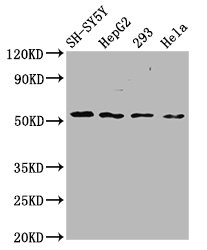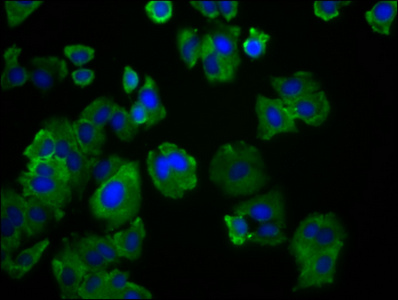SLC19A3 Antibody
-
中文名稱:SLC19A3兔多克隆抗體
-
貨號:CSB-PA866333LA01HU
-
規格:¥440
-
圖片:
-
Western Blot
Positive WB detected in: SH-SY5Y whole cell lysate, HepG2 whole cell lysate, 293 whole cell lysate, Hela whole cell lysate
All lanes: SLC19A3 antibody at 3.6µg/ml
Secondary
Goat polyclonal to rabbit IgG at 1/50000 dilution
Predicted band size: 56 kDa
Observed band size: 56 kDa -
Immunofluorescence staining of HepG2 cells with CSB-PA866333LA01HU at 1:166, counter-stained with DAPI. The cells were fixed in 4% formaldehyde, permeabilized using 0.2% Triton X-100 and blocked in 10% normal Goat Serum. The cells were then incubated with the antibody overnight at 4°C. The secondary antibody was Alexa Fluor 488-congugated AffiniPure Goat Anti-Rabbit IgG(H+L).
-
-
其他:
產品詳情
-
產品描述:
CUSABIO uses the recombinant human SLC19A3/ThTr2 protein (191-282AA) to immunize rabbits and then purify the rabbit antiserum through protein G to obtain the anti-SLC19A3 antibody. This SLC19A3 antibody is a polyclonal antibody and occurs as an unconjugated IgG. Its purity reaches up to 95%. It only shows reactivity with human ThTr2 protein, a thiamine transporter that modulates high-affinity thiamine absorption through a proton anti-port mechanism. And this anti-SLC19A3 antibody has been validated for use in ELISA, WB, and IF applications.
-
產品名稱:Rabbit anti-Homo sapiens (Human) SLC19A3 Polyclonal antibody
-
Uniprot No.:
-
基因名:SLC19A3
-
別名:SLC19A3Thiamine transporter 2 antibody; ThTr-2 antibody; ThTr2 antibody; Solute carrier family 19 member 3 antibody
-
宿主:Rabbit
-
反應種屬:Human
-
免疫原:Recombinant Human Thiamine transporter 2 protein (191-282AA)
-
免疫原種屬:Homo sapiens (Human)
-
標記方式:Non-conjugated
本頁面中的產品,SLC19A3 Antibody (CSB-PA866333LA01HU),的標記方式是Non-conjugated。對于SLC19A3 Antibody,我們還提供其他標記。見下表:
-
克隆類型:Polyclonal
-
抗體亞型:IgG
-
純化方式:>95%, Protein G purified
-
濃度:It differs from different batches. Please contact us to confirm it.
-
保存緩沖液:Preservative: 0.03% Proclin 300
Constituents: 50% Glycerol, 0.01M PBS, pH 7.4 -
產品提供形式:Liquid
-
應用范圍:ELISA, WB, IF
-
推薦稀釋比:
Application Recommended Dilution WB 1:500-1:5000 IF 1:50-1:200 -
Protocols:
-
儲存條件:Upon receipt, store at -20°C or -80°C. Avoid repeated freeze.
-
貨期:Basically, we can dispatch the products out in 1-3 working days after receiving your orders. Delivery time maybe differs from different purchasing way or location, please kindly consult your local distributors for specific delivery time.
-
用途:For Research Use Only. Not for use in diagnostic or therapeutic procedures.
相關產品
靶點詳情
-
功能:Mediates high affinity thiamine uptake, probably via a proton anti-port mechanism. Has no folate transport activity.
-
基因功能參考文獻:
- two siblings who received a refined diagnosis of BTBGD following whole-genome sequencing. Both children inherited compound heterozygous mutations from unaffected parents; a missense single-nucleotide variant (p.G23V) in the first transmembrane domain of the protein, and a 4808-bp deletion in exon 1 encompassing the 5' UTR and minimal promoter region. PMID: 28696212
- Using aggregated exome sequencing data, we calculate the carrier frequency of mutations in SLC19A3 as 1 in 232 individuals in the general population, for an estimated prevalence of the disease of approximately 1 in 215,000 individuals. The disease is thus more frequent than previously recognized PMID: 28402605
- Genetic variations in SLC19A3 play an important role in the pathogenesis of severe diabetic retinopathy and nephropathy and may explain why some individuals with type 1 diabetes are less prone than others to develop microvascular complications. PMID: 26718501
- Genetic screening of SLC19A3 mutation is crucial to diagnosis autosomal recessive biotin-thiamine-responsive basal ganglia disease in asymptomatic relatives presenting with unexplained subacute encephalopathy and abnormal movements. PMID: 27749535
- The direct binding and activation of SLC19A3 expression by HIF-1alpha during hypoxic stress PMID: 27743994
- The mutation of SLC19A3 is related to Biotin-thiamine-responsive basal ganglia disease. PMID: 27905264
- Species differences in the substrate specificity of THTR-2 between human and mouse orthologues were observed. PMID: 26528626
- large genomic deletions occur in the regulatory region of SLC19A3 in Biotin-Thiamine-Responsive Basal Ganglia Encephalopathy PMID: 26863430
- Genetic variation in the SLC19A3 thiamine transporter at 2:228563818T/C may make a modest contribution towards the genetic susceptibility to alcohol dependence syndrome. PMID: 24667528
- This study provided evidence that biotin-thiamine-responsive basal ganglia disease is the result of SLC19A2 mutation. PMID: 24372704
- TM4SF4 interacts with hTHTR-2 and influences the physiological function of the thiamine transporter in human intestinal epithelial cells. PMID: 24282057
- These studies demonstrate that the human intestinal thiamine uptake is adaptively regulated by the extracellular substrate level via transcriptional regulation of the THTR-2 system, and that SP1 transcriptional factor is involved in this regulation. PMID: 23989004
- Glucose-induced decreased expression of thiamine transporters in the tubular epithelium may mediate renal mishandling of thiamine in diabetes. PMID: 23285265
- A new, severe phenotype of SLC19A3 is identified in early-infantile, lethal encephalopathy characterized by subtotal brain degeneration. PMID: 23482991
- Our data shows that SLC19A3 is a new candidate for mutation screening in patients with Leigh syndrome PMID: 23423671
- Two Spanish siblings with a biotin-responsive basal ganglia disease phenotype and mutations in SLC19A3 presented with acute episodes of generalized dystonia PMID: 22777947
- These results suggested that aberrant SLC19A3 promoter hypermethylation in plasma may be a novel biomarker for breast and gastric cancer diagnosis. PMID: 21789241
- The attenuated increase in SLC19A3 expression after HIF-1alpha knockdown suggests a role for HIF-1alpha mediated pathways regulating SLC19A3 gene expression. PMID: 20930543
- these cases broaden the phenotypic spectrum of disorders associated with SLC19A3 mutations and highlight the potential benefit of biotin and/or thiamin treatments and the need to assess the clinical efficacy of these treatments. PMID: 21176162
- Results suggest that methylation of SLC19A3 promoter could be a novel biomarker for early gastric cancer development. PMID: 19816091
- thiamine transporter THTR2 gene expression is down-regulated in breast cancer PMID: 12861052
- characterization of the SLC19A3 promoter in vitro and in vivo and demonstrate the importance of an SP1 cis-regulatory element in regulating promoter activity of this important human gene. PMID: 15217784
- One of the genes up-regulated by SLC19A3 protein (THTR2) transfection was down-regulated by thiamine depletion (CYP4B1) PMID: 15328374
- Expression of SLC19A3 in leukocytes is a relatively sensitive indicator of marginal biotin deficiency. PMID: 15623830
- In this segment, each family displayed one of two different missense mutations that altered the coding sequence of SLC19A3, the gene for a transporter related to the reduced-folate (encoded by SLC19A1) and thiamin (encoded by SLC19A2) transporters. PMID: 15871139
- differentiation of intestinal epithelial cells is associated with an up-regulation in thiamin uptake process which is mediated via transcriptional regulatory mechanisms that involve the SLC19A2 and SLC19A3 genes PMID: 16055442
- analysis of targeting and trafficking of hTHTR1 and hTHTR2 in epithelial cells PMID: 16371350
- Thiamine uptake by HEK-293 cells is mediated via a specific pH-dependent process, which involves both the hTHTR-1 and hTHTR-2. PMID: 16705148
- hTHTR2 mutants (G23V, T422A) both abrogate thiamine transport activity rather than targeting of hTHTR2 to the cell surface. PMID: 16790503
- THTR2 is involved in thiamine transport by reginal pigment epithelium. PMID: 17463047
- Pancreatic beta cells and islets take up thiamine by a regulated THTR1/2-mediated process. PMID: 19423748
顯示更多
收起更多
-
相關疾病:Thiamine metabolism dysfunction syndrome 2, biotin- or thiamine-responsive type (THMD2)
-
亞細胞定位:Membrane; Multi-pass membrane protein.
-
蛋白家族:Reduced folate carrier (RFC) transporter (TC 2.A.48) family
-
組織特異性:Widely expressed but most abundant in placenta, kidney and liver.
-
數據庫鏈接:
Most popular with customers
-
YWHAB Recombinant Monoclonal Antibody
Applications: ELISA, WB, IHC, IF, FC
Species Reactivity: Human, Mouse, Rat
-
Phospho-YAP1 (S127) Recombinant Monoclonal Antibody
Applications: ELISA, WB, IHC
Species Reactivity: Human
-
-
-
-
-
-





















